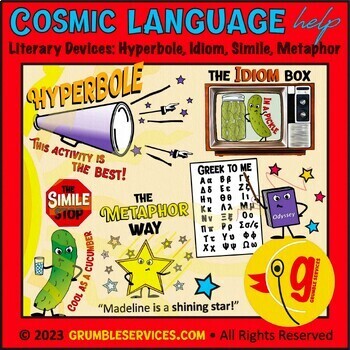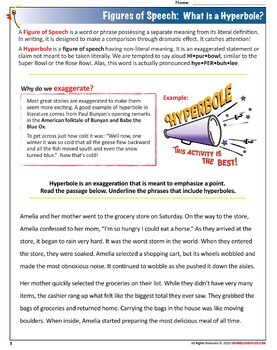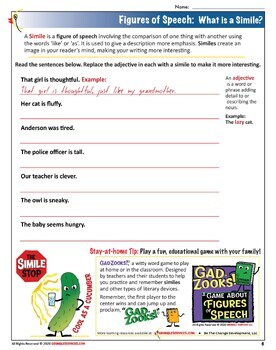Literary Devices: Idioms, Hyperboles, Similes, Metaphors - Figurative Language
- PDF
Also included in
- Cosmic LANGUAGE: Montessori Grammar, Etymology, Vocabulary, Writing Devices (and much more!) BUNDLE - Montessori-inspired Elementary Language Materials for the Classroom or for your Homeschool!Montessori-inspired Language help Materials: What a time saver! Matching Activity cards, Language materialPrice $85.29Original Price $121.85Save $36.56
Description
Literary Devices: Idioms, Hyperboles, Similes, Metaphors - Figurative Language help - SEMiPRO Elementary Montessori-inspired Reading & Writing help (8 pages + key):
Explore the inner workings and nuances of modern English through fun learning activities! This learning resource guides young grammarians to:
- Learn about Literary Devices: Hyperboles, Idioms, Similes & Metaphors
Discover the history behind some of English's most popular figures of speech - Match popular idioms to their meanings
- Practice creating their own Simile, Metaphor & Hyperbole Literary Devices
- Differentiate between Similes & Metaphors.
These pages are designed to ACCOMPANY the Educational GAME:
Educational Family GAME (NO PREP): GadZooks! Literary Devices, Figurative Language help
What are Literary Devices? Learn about four figures of speech: Hyperboles, Idioms, Similes, and Metaphors - through fun learning activities. Discover the history behind some of English's most popular expressions. Match popular idioms to their meanings. Then practice creating your own Simile, Metaphor & Hyperbole literary devices. Finally, are they similes or are they metaphors?
Do you like Literary Devices: Idioms, Hyperboles, Similes, Metaphors - Figurative Language help pages? Consider also the related Literary Device help Learning Resources:
Idiom Literary Device Matching 30 Cards SET 1: Figurative, Nonliteral Language Activity
Language help Cosmic BUNDLE: Elementary Montessori Grammar & Writing Materials
Educational Family GAME (NO PREP): GadZooks! Literary Devices, Figurative Language help
Looking for High Quality, Professionally Designed Elementary Learning Resources? Look no further - FOLLOW GRUMBLE! Although the word Montessori is in the title, ANY type of elementary student will benefit from independent, self-directed learning.
As stated in the Teachers Pay Teachers refund policy, “all sales on TpT of digital resources are considered final and nonrefundable.” Please ask any questions you have about this product before purchasing. Thank you! © 2020-2024 Grumbleservices.com • All rights reserved.
Dr. Maria Montessori believed the only way our world would find lasting peace was through educating our children. Much of her elementary curriculum was written by her during a period of internment in India during WWII. This time period helped solidify Dr. Montessori’s belief in Peace Education.
Resource Color Guide (just like the Montessori hierarchical colors):
ROOKIE Pages (Green) - Aimed toward early to mid level elementary students.
SEMiPRO Pages (Blue) - Aimed toward mid level elementary students.
VETERAN Pages (Red) - Aimed toward mid to late level elementary students.
But of course, you know the child best, so adjust accordingly.
In the words of Dr. Montessori, "Follow the Child!"






